Welcome to the definitive types of squash & pumpkins list! There are so many varieties of squash and pumpkins, from small green squash (like Kabocha and Buttercup) to large blue pumpkins (hello Hubbard) – and everything in between.
This guide to all of the different types of squash helps you identify them, learn all about them, and how to cook them, too!
Squash, which includes pumpkins, is a type of fruit that lives within the gourd family, the scientific name of which is called “Cucurbitaceae.” While it’s scientifically a fruit, it’s treated more like a vegetable.
There are SO many types of squash out there, but the two main categories are winter squash, like pumpkins, butternut squash, and spaghetti squash; and summer squash, like zucchini and pattypan.
Butternut squash is one of the most popular winter squash varieties, prized for its sweet, nutty flavor and smooth, creamy texture when cooked. Its tan skin and distinct squash shape make it easy to identify. If you want to learn how to spot butternut squash, see pictures of it growing on the vine, harvested, prepared, and incorporated into delicious dishes, this photo guide provides helpful visual examples.
Identifying Butternut Squash Plants and Fruit
Butternut squash grows on sprawling vines that can spread 10 feet or more when established. The vines have large leaves and produce yellow trumpet-shaped flowers in summer. The oblong squash itself grows to 6-9 inches long with tan, sometimes pale orange skin. Butternut forms on the vines, not underground. They ripen in early fall when the rind hardens.
Here are tips for identifying butternut squash plants and fruit:
- Vining growth habit with large leaves
- Yellow flowers on same plant
- Smooth tan skin, sometimes with orange blush
- Oblong shape, 6-9 inches long
- Bulbous base tapering to curved neck
- Tan color when ripe
- Hard, tough rind when mature
- Cork-like stem attaches it to vine
Butternut Squash Harvest
Butternut squash is ready for harvesting in early fall once the rind fully hardens and changes from green to tan. Ripe butternut feels heavy and sounds hollow when tapped. Use a sharp knife to cut squash from the vine, leaving 3-4 inches of stem.
Signs butternut squash is ripe
- Skin turns tan and feels hard
- Yellow ground spot on bottom
- Deep orange interior when cut
- Stem withers and dries up
- Heavy for its size
Handle ripe butternut gently to prevent cuts and bruises. Store whole squash in a cool, dry area to preserve quality.
Different Varieties of Butternut Squash
While traditional butternut has tan skin and orange flesh there are some other varieties to know
- Waltham – Most common. Sweet nutty flavor.
- Early Butternut – Ready earlier, smaller.
- Honeynut – Extra sweet, smaller.
- Queensland Blue – Blue-gray skin, heirloom.
- Butterscotch – Dark orange flesh, very sweet.
Selecting Butternut Squash at the Market
When buying butternut squash, look for:
- Hard, tough tan rind without cuts or bruises
- Heavy for size and feels firm
- Dull not glossy rind
- Deep orange interior when cut
- Intact stem, not shriveled
- Sweet, nutty aroma
Peak season is fall and early winter, but butternut can be found year-round. Check farmers markets for fresh, local varieties.
Preparing and Cutting Butternut Squash
Butternut squash has a tough outer rind that needs to be removed before cooking. Here is how to prepare it:
- Cut in half lengthwise and scoop out seeds
- Peel rind with knife or vegetable peeler
- Chop, dice, or cube to desired size
The seeds can also be washed, roasted and eaten as a snack. Once cut store squash in the refrigerator and use within 5 days.
Cooking With Butternut Squash
When cooked, butternut squash becomes tender with a sweet, nutty flavor and creamy texture. It’s delicious prepared by:
- Roasting – Toss cubed squash in oil, roast at 400°F until tender.
- Puréeing – Scoop out flesh, blend/mash to make soup or purée.
- Sautéing – Dice and sauté in oil or butter until softened.
- Baking – Halve and bake cut-side down until easily pierced.
- Steaming – Add cubes to steamer basket, steam until fork-tender.
- Grilling – Slice into 1-inch planks, grill 8-10 minutes per side.
Butternut can be used in everything from risottos, pastas, and curries to frittatas, breads, and muffins.
Butternut Squash Recipe Ideas
Here are some tasty ways to use butternut squash:
- Hearty squash soups – Garnish with herbs or toasted pepitas.
- Ravioli or gnocchi – Stuff with cubed roasted butternut.
- Risottos – Combine with squash, sage, and Parmesan.
- Salads – Toss with spinach, feta, and pumpkin seeds.
- Pizza – Top with sliced squash, onions, and broccoli.
- Quiches/frittatas – Add wilted greens and roasted diced squash.
- Pasta – Toss with squash, bacon, and Parmesan.
- Baked goods – Add puréed squash to breads, muffins, and cakes.
Photos of Butternut Squash Dishes
Seeing these dishes provides inspiration for how to creatively use this healthy winter vegetable:
- Hearty puréed soup garnished with chopped toasted pepitas
- Stuffed ravioli or gnocchi with cubed roasted butternut
- Risotto with sautéed squash, fresh sage, and shaved Parmesan
- Colorful salad with spinach, roasted squash slices, feta, and pumpkin seeds
- Pizza with butternut chunks, caramelized onion, broccoli, and melted cheese
- Frittata slices filled with wilted kale and roasted diced butternut
- Farfalle pasta in creamy sauce with bacon and butternut
- Quick bread or muffins with swirls of bright orange puréed squash
With its signature shape, color, and sweet flavor, butternut squash makes for beautiful and appetizing dishes perfect for fall.
Butternut Squash Growing on the Vine
Seeing where butternut squash originates helps appreciate this hardy winter vegetable. Pictures of butternut on the sprawling vines show:
- Large, spreading vines and big leaves
- Yellow trumpet-shaped flowers that bloom first
- Oblong smooth-skinned squash attached to vines by a cork-like stem
- Green squash that ripens to tan rind in fall
Watching butternut develop from flower to mature hard-skinned fruit gives a sense of its growing cycle.
From Harvest to Table
Following butternut squash from harvest to table illustrates the journey of this wholesome food:
- Plump tan squash cut from vines with stems intact
- Heaps of butternut at farmers markets and grocery stands
- Prepping squash by cutting in half, scooping out seeds
- Chopping into cubes for roasting or puréeing
- Adding roasted or sautéed squash to delicious recipes
- Enjoying butternut squash meals with family and friends
Seeing the process from vine to harvest to kitchen gives an appreciation for this nutritious and flavorful vegetable that graces autumn tables.
The Beauty of Butternut Squash
Butternut squash is not just tasty – it is also beautiful! Pictures show:
- Deep orange color that provides a pop of color
- Interesting ridged shape and bulbous bottom
- Tan rind that contrasts with orange interior
- Distinctive squash shape when diced into dishes
With its bright hue, unique texture, and sweet flavor, butternut squash is both a delightful edible treat and stunning addition to seasonal décor.

Golden Ace Acorn Squash

Cucurbita pepo (Acorn Group). Winter squash. There are a few gold Acorn Squashes, but I picked up this little cutie at a local farmer’s market and fell in love. Golden Ace Acorn Squash is a petite heirloom acorn squash, about two pounds. Its hue is golden-orange, with orange-yellow flesh that’s reportedly far more flavorful – mildly nutty, slightly sweet, pumpkiny – than your standard Acorn Squash.

Cucurbita moschata. One of the new darlings of the squash world, Honeynut Squash is a butternut hybrid and indeed looks like a baby butternut with a deeper buff hue. These beautiful little winter squashes only grow to about 6 inches long and 1-2 pounds. The flesh is very sweet and creamy.
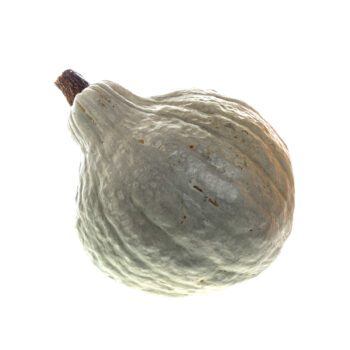
Cucurbita maxima (Hubbard group). This big blue behemoth might seem intimidating, but it’s worth the effort! Hubbard Squash is a blue-gray winter squash ranging in size from 5 to 40 (yes, 40!) pounds.
Its almost impossibly thick skin makes it a winter squash that can store for longer than almost any of them. But this means the skin is also very difficult to cut through – people try everything from cooking it whole in the oven for awhile first (not recommended) to breaking out the power tools! My favorite method comes from Heartbeet Kitchen’s Amanda Paa in her book Smitten with Squash (affiliate link) – she likes to crack it open with a hammer or wrap it in a garbage bag and drop it on the cement, then cut into smaller pieces, pre-bake at 300 degrees Fahrenheit for about 15 minutes, scrape off the peel and seeds, and THEN cut into chunks and proceed with cooking it. Also known as Blue Hubbard Squash.
Flat White Boer Pumpkin
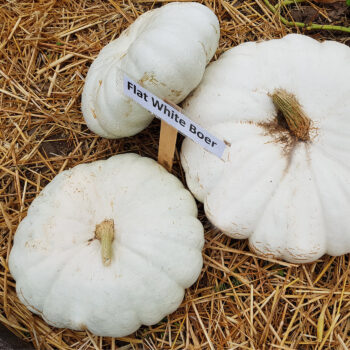
Cucurbita maxima. This large (10-30 pound), flat, white, gently ribbed pumpkin is gorgeous in displays (especially stacked towers!), but is excellent for eating as well. The orange flesh is very sweet and beloved in pies and baked goods.
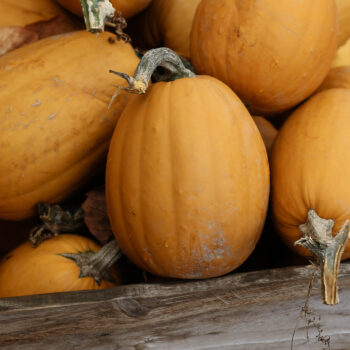
TBD. Fools Gold pumpkin is pretty in displays, adding a unique caramel color and tall shape. Larger in size, it averages 10-12 pounds.
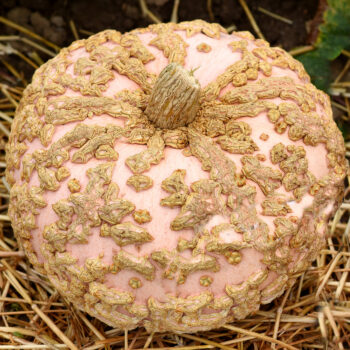
Cucurbita maxima. This unique French heirloom pumpkin features peachy-pink skin covered in warty, corky, peanut-like growths! This one is large – 10 to 20 pounds. If you’re looking for a unique ornamental pumpkin with loads of texture, this is it. But it’s excellent eating, too – the flesh is exceedingly sweet, perfect for pies and baking.
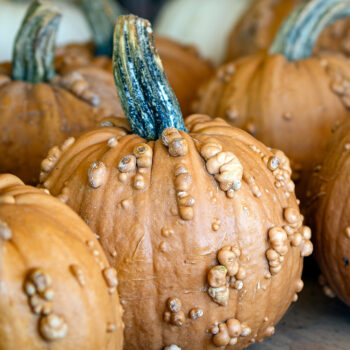
Cucurbita pepo. True to its name, Grizzly Bear Pumpkin is brown and warty – just like its namesake! Okay, so maybe grizzlies aren’t warty – but the caramel hue of both the pumpkin and the bear set them apart. Medium to large in size, these 6-10 pound pumpkins are gorgeous for displays and sometimes used for carving too. This hard-shell pumpkin is grown more for its looks than for eating.

Cucurbita maxima (Zapallito Group). This tiny round winter squash weighs in at 1-2 pounds each. The skin is deep orange with a green stripe around the stem. Gold Nugget Squash was originally bred to be grown as a substitute for sweet potato in colder climates where sweet potato can’t grow. Like sweet potatoes, Gold Nugget Squash has a starchy texture and sweet taste. Gold Nugget Squash is sometimes cooked whole (pierce the flesh first to allow steam to escape!) due to its hard rind. On the plus side, that hard rind makes it an excellent storer.
How to Make Roasted Butternut Squash
FAQ
What is the best way to eat butternut squash?
-
Food52https://food52.comThe Absolute Best Way to Cook Butternut Squash – Food52Dec 13, 2022 — The overall best methods for evenly crispy squash with flavorful flesh and maximal seasoning were: Roast in Cubes and Roast in Wedges (use a lower o…
-
Reddit · r/EatCheapAndHealthyhttps://www.reddit.commore creative/satisfying way to eat butternut squash? – RedditDec 12, 2018 — Favorite uses: * in salads. * mashed (with butter and a little maple syrup. almost like a lighter version of mashed sweet potato) * butternut squas…
Which is healthier, sweet potato or butternut squash?
To begin with, the butternut squash beats the sweet potato with fewer calories, carbs and sugar per serving. Moreover, it is rich in calcium, magnesium, potassium, and vitamins B6 and E. On the other hand, the sweet potato, however, provides more fiber and protein.
How do you know when butternut squash is ready to eat?
- Hard rind: A ripe butternut squash should have a hard rind that resists being pierced by a fingernail.
- Brown, shriveled stem: The stem should be dry and shriveled, not green and vibrant.
- Dull, mature color: The skin should be a dull, mature tan or orange-tan color, not bright green or yellow.
- No glossy or shiny appearance: The skin should be dull, not shiny or glossy.
- Avoid squashes with cuts or soft spots: These indicate potential rot or mold.
- Avoid brown marks: Brown marks can be a sign of frost damage and may indicate the squash won’t last as long.
Do you have to peel butternut squash before cooking?
- Roasting: You can roast butternut squash with the skin on, as it will soften and become more palatable during roasting.
- Pureeing: When making soup or other puréed dishes, peeling is recommended to achieve a smooth and fine texture.
- Other cooking methods: For methods like braising or steaming, peeling is generally preferred.
How many butternut squash stock photos are there?
Browse 4,235 authentic butternut squash stock photos, high-res images, and pictures, or explore additional butternut squash soup or roasted butternut squash stock images to find the right photo at the right size and resolution for your project. Caucasian woman slicing a Butternut Squash on a wooden cutting board.
What does butternut squash taste like?
Fresh Butternut Squash Isolated Fresh Butternut Squash Isolated on a white background. This vegetable has a sweet nutty taste and is similar to a pumpkin. Although it is a fruit it, can also be used as a vegetable. The insides can be scraped out and used as an ingredient for many recipes. This food is a member of the gourd family.
What does honeynut squash look like?
Honeynut Squash looks just like a small butternut squash because it is a hybrid of butternut. It is also sweeter, has a darker orange pulp, and a thinner skin meaning you can roast them without peeling. Use them in any butternut recipe for which you want a sweeter flavor.
What is butternut squash used for?
It is used as a vegetable for savory side dishes. Zucchini bread, of course, is a big favorite. Butternut squash is known for its sweet, nutty taste. This winter squash produces medium-sized fruits with beige skin and orange flesh, and needs a lot of room to grow.
What is a zucchini & butternut squash?
Zucchini is a summer squash that, left on the vine, can grow to more than three feet long, but for cooking it’s usually harvested at 1/4 that size or smaller. It is used as a vegetable for savory side dishes. Zucchini bread, of course, is a big favorite. Butternut squash is known for its sweet, nutty taste.
Is butternut squash a carnival squash?
Look here for Butternut Squash Nutritional Info and So Much More. Carnival squash, sometimes called carnival pumpkins, have a striking appearance with vibrant patches of orange, green, and sometimes yellow, giving them a festive look reminiscent of a carnival, hence the name.
